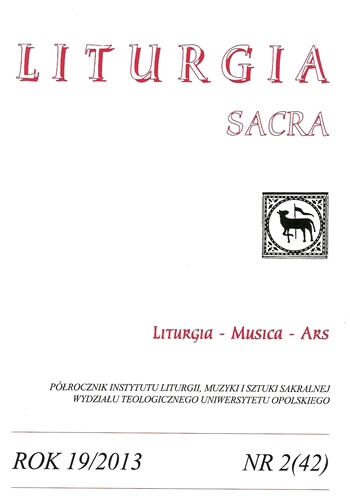Uczestnictwo wiernych w odnowionej liturgii
Faithful Participation in the Renewed Liturgy
Pros and cons
Author(s): Rudolf PierskałaSubject(s): Christian Theology and Religion
Published by: Uniwersytet Opolski
Keywords: Renewed Liturgy;
Summary/Abstract: In the Constitution of liturgy there is no single unified definition on participation, but described them in many places with different terms. The word “participate” itself is part of the Constitution twenty-five times. In contrast, the quality of this participation is illustrated in ten different definitions. Mostly it is talking about the active participation fifteen times. (KL 11, 14, 19, 21, 26, 27, 30, 41, 48, 50, 79, 113, 114, 121, 124) Then, four times about participation as: conscious (KL 11, 14, 48, 79), full (KL 14 twice, 21, 41) and Community (KL 21, 27, 29, 100). And two times about devout participation (KL 48, 50). Singly, it is mentioned in the form like: fruitful (KL 11), easy (KL 79), external and internal (KL 19), whole soul (KL 17), perfect (KL 55), ceremonial (KL 113). All these terms bring us closer to understanding the intended method of participation by the Church of the faithful in the liturgy, especially the Eucharist, to which the faithful by virtue of the sacrament of baptism are entitled and obliged (KL 14). A model way of participation of the faithful in the mystery of the Eucharist in the Constitution on the Liturgy in No. 48 as follows: The church concerns that, Christians during this mystery of faith shouldn’t be strangers and silent spectators, but through the rites and prayers understood this mystery well, and participated in the sacred action: consciously, actively and with devotion. It is formed by the word of God, nourished at the Lord's Table and give thanks to God. Then offering the immaculate host and not only through the hands of the priest but also together with him learned to sacrifice themselves. Through Christ are in perfect union with God and with one another so finally God may be all in all. This text becomes a kind of integrated program describing how the participation of the faithful in the liturgy. It also shows an exemplary manner of the participation of the faithful in liturgy, which was intended by the Council. Hence, this will form the basis of our discussion after 50 years from the end of the Council. We want to present the pros and cons of the faithful participation of the liturgy. Showing first the attributes of the faithful participation, then model how the participation of the faithful in the liturgy would be. White Pontifical Cassock in sources of Iconographic and Literature.
Journal: Liturgia Sacra
- Issue Year: XIX/2013
- Issue No: 42
- Page Range: 371-384
- Page Count: 14
- Language: Polish
- Content File-PDF

